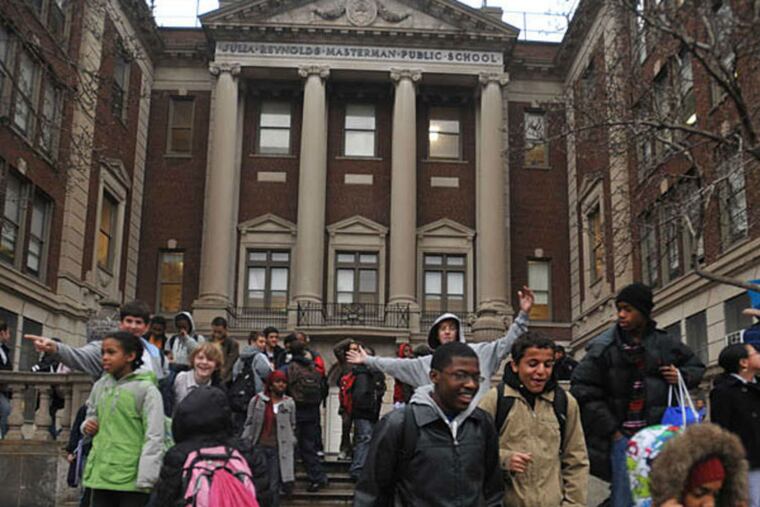Who gains admission to Philly's selective high schools?
A Pew analysis of Philadelphia high school admissions found that on the whole, the city's selective high schools had more white and Asian students than other city schools, and fewer students living in poverty, English language learners and students who need special education services.

Philadelphia's selective public high schools do not look like other city schools: they have higher percentages of white and Asian students and lower percentages of students living in poverty, learning English and receiving special-education services, according to an analysis by the Pew Charitable Trusts released Thursday.
The examination of the Philadelphia School District's high school selection process for the 2015-16 school year also found that while some students who qualified academically did not gain admission, other students who did not meet admissions standards got in — though that mostly happened in schools where there were leftover seats after all qualified students were given spots.
Philadelphia's high school admission system is complex — there are district schools and charters; neighborhood high schools, which take all students; and two tiers of special admissions: magnet schools, with the most stringent academic and behavioral requirements, and citywide admissions, which still require good grades and test scores and a strong behavioral record.
Unlike some other large cities, such as New York, Philadelphia has a centralized application process, but the final decision about admissions is left up to individual schools. Some students get into multiple schools; others are shut out of all of their choices.
The overrepresentation of white and Asian students, students not living in poverty, students for whom English is the first language, and students who do not receive special education services is due in large part to applicants' academic qualifications — grades and standardized tests scores — the report said. The groups that had a better shot at getting into selective high schools all performed better on those tests.
Geography also matters, the report found. Students who live in West Philadelphia, North Philadelphia and Northeast Philadelphia — relatively far from most programs, or not as accessible by public transportation — are less likely to enroll in specialized schools and programs. Students in Center City and Northwest Philadelphia were more likely to gain admission.
Most students who had the academic records to get into a selective high school applied. But one surprising conclusion, study author Michelle Schmitt said, was that a significant portion of Latino students who had the test scores to qualify for special admissions schools did not bother applying.
District officials told Pew they were concerned about this, and offered a theory that young Latino students might be hesitant to leave their neighborhoods for faraway schools, a notion that is supported by research from other cities.
Also, "if you visit a school and you don't see people who look like you, you may not see yourself attending the school," Karyn Lynch, the district's chief of support services, told Pew.
Other officials went a step further, wondering whether the district was going far enough to recruit Latino students, especially those whose families have a language barrier.
"Language access is not translating papers," said Daniela Romero of the district's office of community engagement. "You have to do workshops and make sure people understand the process and know why it is important."
White students who attend a special admission schools concentrated at a few of them in ways that can't be explained by geography alone, Pew found. Central, the Arts Academy at Benjamin Rush, Masterman and the magnet program at Northeast High all had over-representations of white students. Asian students congregated at Central and Northeast's magnet program.
Systemwide, there were more girls and fewer boys in the city's special admissions programs. District-wide, 51 percent of high school freshmen were boys and 49 percent were girls, but in selective programs, it was 41 percent boys and 59 percent girls.
Some special admissions programs had student bodies made up of high percentages of black students — Parkway West, Parkway Northwest, Lankenau, Motivation, Hill-Freedman, Carver and Parkway Center City. Others had lower than expected percentages of black students: GAMP, Rush Arts, Central, Northeast, Masterman and George Washington's International Baccalaureate program.
Disproportionately high percentages of Latino students enrolled at Bodine and Franklin Learning Center.
Schools that enrolled a higher-than-expected percentage of students living in poverty included Parkway West, Motivation, Philadelphia High School for Girls and Franklin Learning Center; those with lower-than-expected percentages of poor students include Masterman, Science Leadership Academy, GAMP, and the magnet program at George Washington.
Few special education students made it into magnet high schools, and those who did tended to concentrate at Franklin Learning Center, Hill-Freedman and Saul. English-language learners, also underrepresented in selective high schools, mostly attended Central, Girls' High and the Academy at Palumbo.
The administration of former Mayor Michael Nutter requested the analysis, which was completed with district cooperation. Pew asked charter schools to participate; 11 of the city's 31 charter high schools cooperated.
Schools spokesman Lee Whack said in a statement that the Pew report contains important information and that the district is "committed to having a system of choice that provides all children with access to the opportunities they deserve."
"The report shows we must continue to enable greater access to the school application/selection process and provide more information to parents and students about all available school options so they can make the best decision possible," Whack said.
The school district's application process for the 2018-19 school year opens at the end of the month; a high school fair will be held at the Pennsylvania Convention Center on Friday and Saturday.